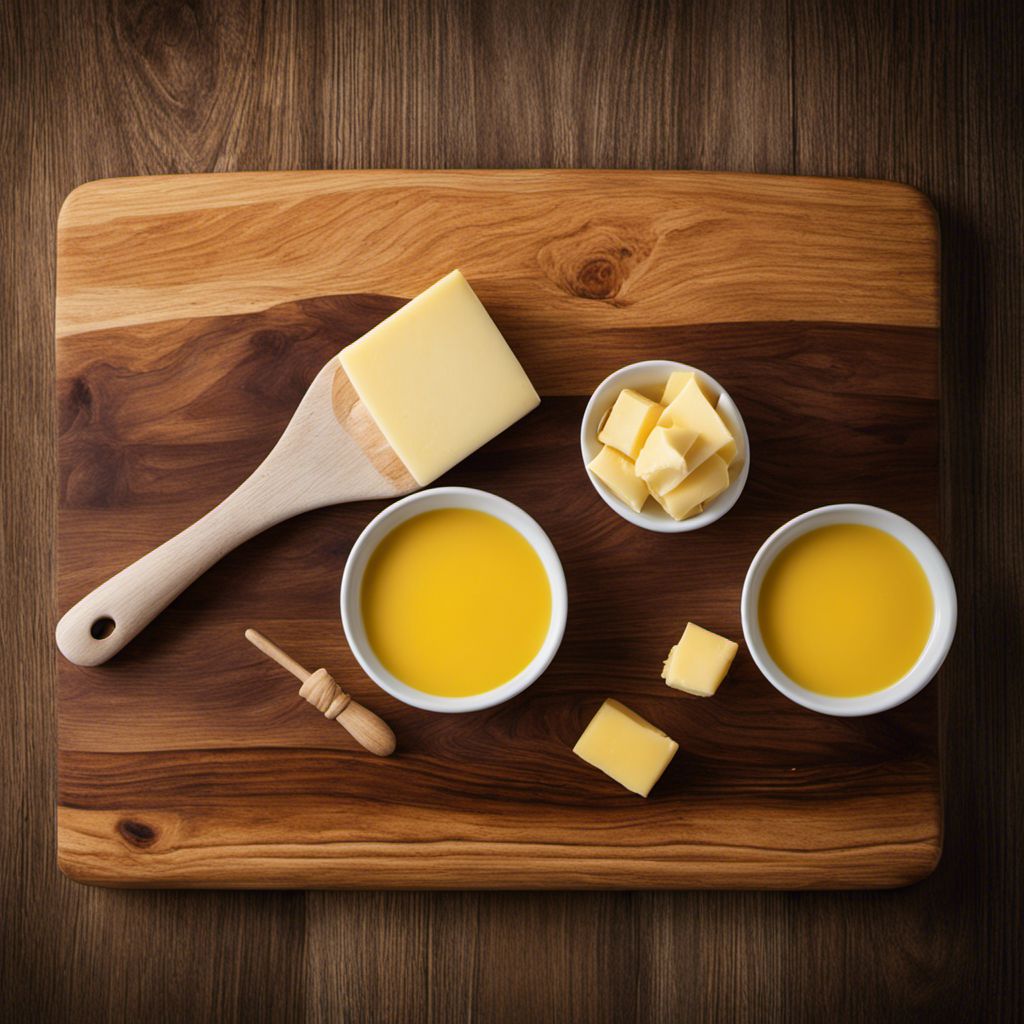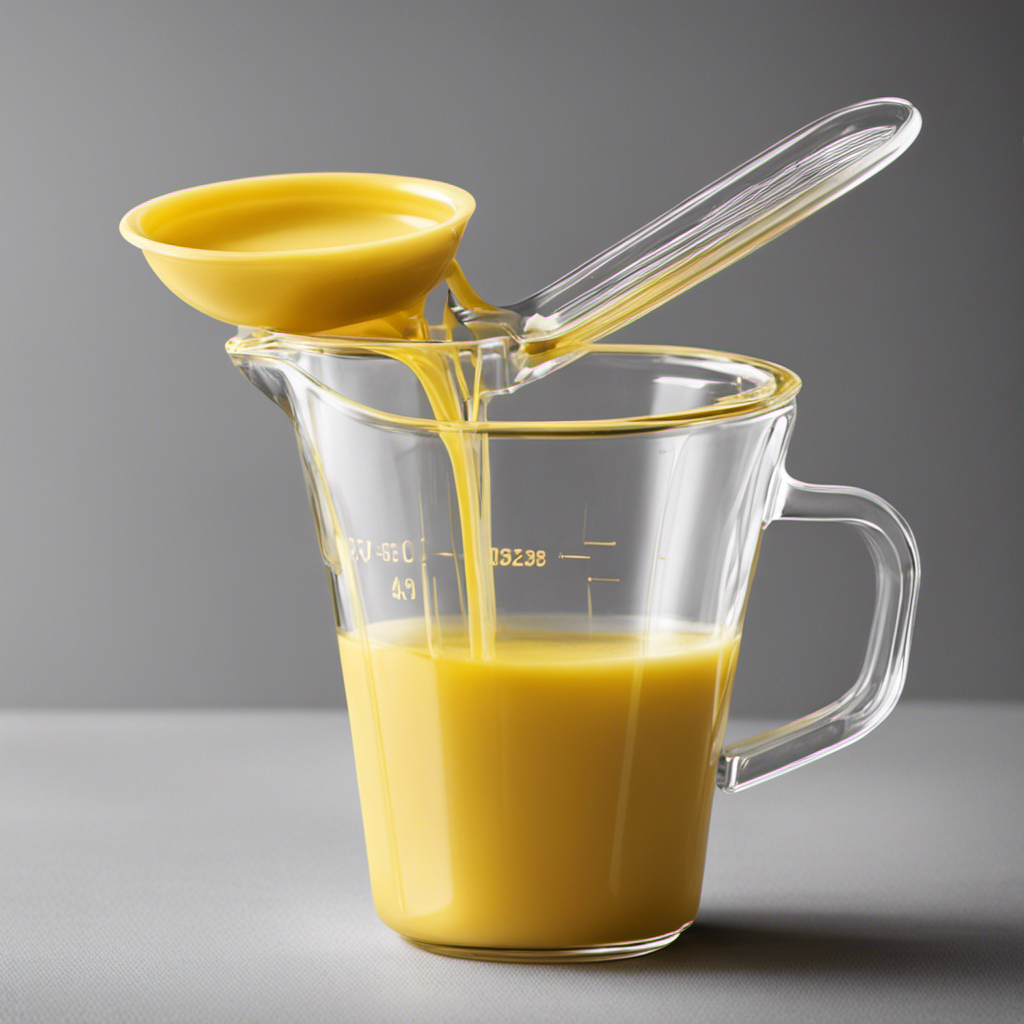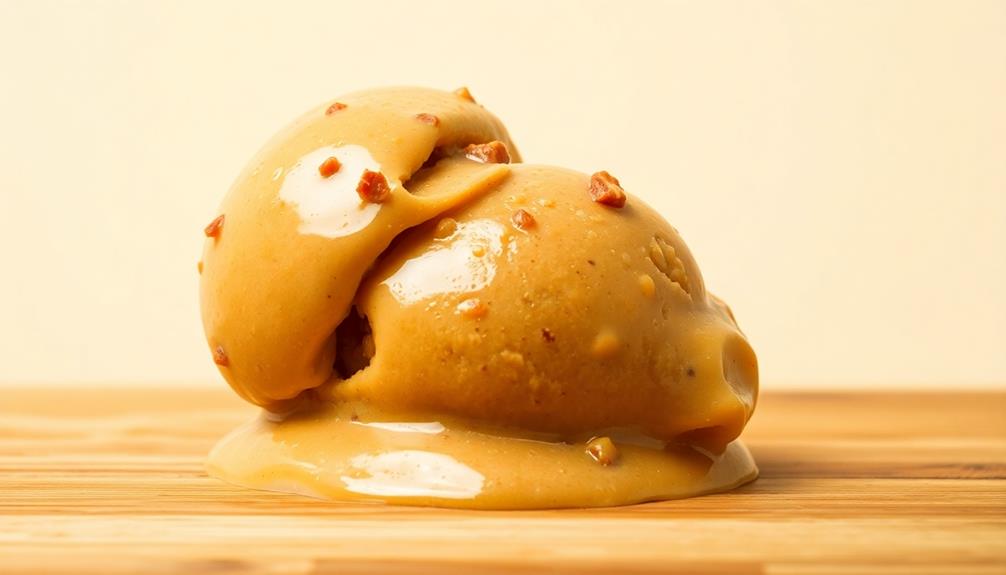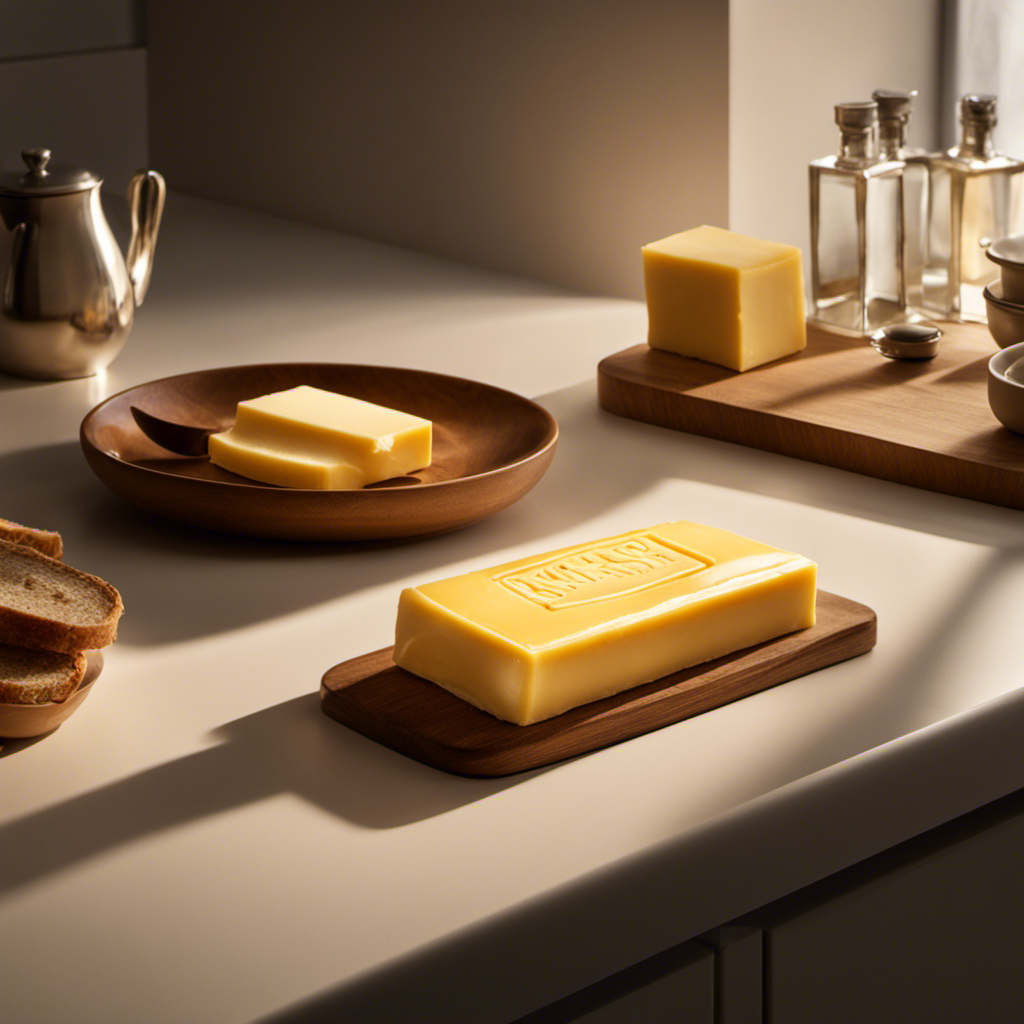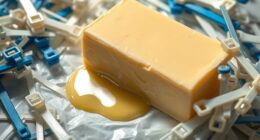Ever been halfway through preparing a recipe when you suddenly discover you’re missing the precise amount of butter needed? Worry no more! I’m here to clarify the longstanding query: How many tablespoons make up a stick of butter?
In this article, we’ll dive into the butter-to-tablespoon ratio, learn how to convert sticks of butter to tablespoons, and explore quick and easy butter equivalents.
Get ready to become a butter measurement pro in no time!
Key Takeaways
- 1 stick of butter is equal to 8 tablespoons.
- Accurate measurements are crucial for following recipes.
- Different brands and types of butter may have different measurements.
- Soften butter at room temperature for easy scooping.
Understanding the Butter-to-Tablespoon Ratio
1 stick of butter is equal to 8 tablespoons. Understanding the butter-to-tablespoon ratio is essential for any cook or baker.
When it comes to measuring butter, it is important to know the equivalent in tablespoons. This knowledge can simplify your cooking process and ensure accurate measurements. To convert butter to tablespoons, divide the total number of tablespoons by 8. For example, if a recipe calls for 1/2 a stick of butter, you would need 4 tablespoons.
When measuring butter, it is crucial to use the correct amount to achieve the desired texture and flavor in your dishes. Remember to use a liquid measuring cup for accurate measurements and ensure the butter is at room temperature for easy blending.
These butter measurement tips will help you master your recipes with precision and confidence.
Converting Sticks of Butter to Tablespoons
To figure out how much butter you need, convert a stick into tablespoons. A stick of butter is equal to 8 tablespoons or 1/2 cup. This is a standard measurement in recipes, especially in the United States.
When converting butter in recipes, it’s important to know this ratio, as it will ensure accurate and consistent results. Whether you’re baking a cake, making cookies, or sautéing vegetables, knowing how many tablespoons are in a stick of butter is a valuable measurement tip.
It allows you to easily adjust the amount of butter needed, depending on your recipe’s requirements. So the next time you’re in the kitchen and a recipe calls for butter, remember that 1 stick equals 8 tablespoons or 1/2 cup, making it easy to convert and use in your culinary creations.
Kitchen Measurements: Butter in Tablespoons
Remember, you’ll need to know the conversion ratio for butter in tablespoons to ensure accurate measurements in your recipes.
When it comes to kitchen tools and baking measurements, understanding the precise measurement of tablespoons in a stick of butter is essential. A stick of butter typically contains 8 tablespoons, making it easy to measure and incorporate into your recipes.
Having this knowledge allows you to accurately follow recipes and achieve the desired results in your baking endeavors. By using tablespoons as a unit of measurement, you can easily portion out the right amount of butter needed for your culinary creations.
Now that you understand the conversion ratio, let’s delve into how to measure butter in tablespoons and make your baking adventures even more successful.
How to Measure Butter in Tablespoons
When measuring butter in tablespoons, it’s important to follow the conversion ratio accurately. To help you better understand and enjoy the process of measuring butter accurately, here are some key points to consider:
-
Understanding the conversion ratio: One stick of butter is equal to 8 tablespoons or 1/2 cup.
-
Using a measuring tool: To measure tablespoons of butter, use a measuring spoon specifically designed for tablespoons. This ensures accuracy in your measurements.
-
Softening the butter: To easily measure tablespoons of butter, it’s best to soften it at room temperature. This allows for easy scooping and accurate measurement.
By following these steps, you can confidently measure butter accurately in tablespoons. Whether you’re baking or cooking, precise measurements are crucial for achieving the desired taste and texture in your dishes.
Butter Equivalents: Sticks to Tablespoons
When it comes to measuring butter in tablespoons, it’s important to understand the conversion from sticks to tablespoons.
One stick of butter is equal to 8 tablespoons, making it easy to measure out the desired amount for a recipe.
However, if you don’t have a stick of butter on hand, there are alternative ways to measure it using tablespoons or weight measurements.
Accurate measurements are crucial in baking and cooking, as they can greatly affect the outcome of a dish.
Stick to Tablespoon Conversion
To convert a stick of butter to tablespoons, you can use the ratio of 1 stick equals 8 tablespoons. This conversion is handy when following recipes that require specific measurements.
Here are some important details about stick to tablespoon ratio and converting butter measurements:
-
The stick to tablespoon ratio is 1:8, meaning that for every stick of butter, you will need 8 tablespoons.
-
Converting butter measurements is essential for accurate baking and cooking. It ensures that you use the correct amount of butter in your recipe.
-
Recipes often provide measurements in sticks, but some may require tablespoons. Knowing the conversion ratio allows you to easily switch between the two measurements.
-
Using tablespoons as a measurement can be more precise in certain recipes that require smaller amounts of butter.
-
Understanding the stick to tablespoon ratio helps you maintain consistency in your cooking and baking, ensuring the best results every time.
Butter Measurement Alternatives
If you don’t have a stick of butter on hand, you can try alternative measurements like using cups or grams instead. While a stick of butter typically measures 1/2 cup or 113 grams, it’s important to note that these measurements may vary depending on the brand or type of butter you are using.
To convert a stick of butter to tablespoons, you would multiply the number of sticks by 8. So, one stick of butter is equal to 8 tablespoons. If you prefer using cups, one stick of butter is equivalent to 1/2 cup. Alternatively, you can also measure butter in grams, with one stick being approximately 113 grams.
These alternative measurements can come in handy when you don’t have a stick of butter available or if you prefer using a different unit of measurement. Now that you know the butter conversion techniques, let’s explore the importance of accurate measurements in cooking.
Importance of Accurate Measurements
Accurate measurements are crucial for ensuring the success of your cooking. As a food scientist, I understand the importance of precise measurements in achieving the desired results in the kitchen. Here are some key points to help you appreciate the significance of accurate measurements:
- Consistency: Precise measurements ensure that your recipes turn out consistently delicious every time you prepare them.
- Balance of flavors: Accurate measurements help maintain the balance of flavors in your dishes. Too much or too little of an ingredient can significantly alter the taste.
- Textural perfection: Measuring ingredients accurately guarantees the perfect texture and consistency of your baked goods and other culinary creations.
Now, let’s discuss some common mistakes in measuring:
- Eyeballing: Guessing the amount of an ingredient can lead to inconsistent results.
- Scooping flour: Scooping flour directly from the bag can result in a compacted cup, leading to dense and dry baked goods.
- Misreading measurements: Misinterpreting recipe measurements can throw off the entire dish.
Quick and Easy Butter Conversion: Sticks to Tablespoons
As a food scientist, I understand the confusion that can arise when it comes to measuring butter accurately.
One of the key points of contention is the conversion from sticks to tablespoons.
It is important to know that one stick of butter is equal to 8 tablespoons, simplifying calculations and ensuring precise measurements in your recipes.
Butter Measurement Confusion
You might be confused about how many tablespoons are in 1 stick of butter. Let me clear up the confusion for you.
Here are some important points to consider:
-
Common misconceptions:
-
Many people believe that 1 stick of butter is equal to 1 cup, but that is not true.
-
Another misconception is that all butter packaging is the same, but different brands and types of butter may have different measurements.
-
Different butter packaging:
-
In the United States, a standard stick of butter is typically 1/2 cup or 8 tablespoons.
-
However, some European butter sticks may be slightly larger, measuring around 9 tablespoons.
-
Converting sticks accurately:
-
To convert sticks of butter to tablespoons, simply multiply the number of sticks by 8.
-
For example, if a recipe calls for 2 sticks of butter, you would need 16 tablespoons.
Now that you know the exact measurement and have debunked some common misconceptions, let’s move on to exploring how to accurately convert sticks of butter into other measurements.
Converting Sticks Accurately
Let’s now delve into the process of converting sticks of butter into other measurements. Understanding butter ratios and measuring butter accurately are essential skills for any home cook. To help you with this, I have created a table that shows the exact measurements of tablespoons in a stick of butter:
| Sticks of Butter | Cups | Tablespoons |
|---|---|---|
| 1 | 1/2 | 8 |
| 2 | 1 | 16 |
| 3 | 1 1/2 | 24 |
| 4 | 2 | 32 |
| 5 | 2 1/2 | 40 |
Simplifying Tablespoon Calculations
By referring to the table, it’s easy to convert sticks of butter into cups or tablespoons. As a food scientist, I understand the importance of simplifying conversions and measurements for the audience.
Here are three ways to make the process more enjoyable:
-
Use visual aids: Provide a conversion chart that clearly shows the number of tablespoons in a stick of butter. This visual representation makes it easier for readers to understand and visualize the measurements.
-
Provide practical examples: Share simple recipes or cooking tips that involve using a stick of butter. By incorporating real-life scenarios, readers can see the practicality of converting sticks to tablespoons in their everyday cooking.
-
Explain the rationale: Describe why it’s important to convert measurements accurately. Understanding the reasons behind the conversions can help readers appreciate the precision required in cooking and baking.
Frequently Asked Questions
Can I Use Margarine Instead of Butter in Recipes That Call for Sticks of Butter?
Yes, you can use margarine as a substitute for butter in recipes that call for sticks of butter. However, keep in mind that the texture and flavor may be slightly different.
How Do I Convert Tablespoons of Butter to Grams or Ounces?
Converting butter measurements is crucial for measuring butter accurately in recipes. To convert tablespoons of butter to grams or ounces, you can use conversion charts or online calculators for precise measurements.
Is There a Difference Between Salted and Unsalted Butter in Terms of Tablespoon Measurement?
There is a difference between salted and unsalted butter. In terms of tablespoon measurement, it remains the same. To accurately measure tablespoons of butter, use a measuring spoon or refer to the markings on the packaging.
Can I Use a Different Type of Fat, Like Oil or Shortening, as a Substitute for Butter in Recipes?
Yes, you can use different fats like oil or shortening as substitutes for butter in recipes. However, keep in mind that the texture and flavor may be affected. It’s best to follow a trusted recipe for accurate measurements and results.
Are There Any Special Considerations When Measuring Butter in Tablespoons for Baking Recipes?
When measuring butter in tablespoons for baking recipes, there are a few special considerations to keep in mind. To accurately measure, soften the butter to room temperature and use a measuring spoon to scoop the desired amount.
Conclusion
In conclusion, there are 8 tablespoons in 1 stick of butter.
This precise measurement is crucial in various recipes to achieve the perfect balance of flavors and textures.
Just like a symphony conductor expertly directs each instrument to create a harmonious melody, understanding the butter-to-tablespoon ratio allows us to create delectable dishes.
So next time you’re in the kitchen, confidently convert sticks of butter to tablespoons and let your culinary creations sing with precision and flavor.
